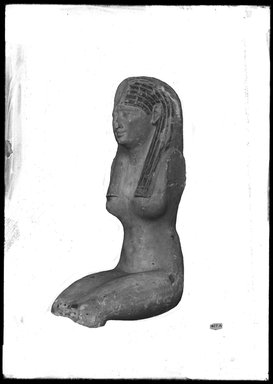
Medium: Plaster, wood, pigment
Geograhical Locations:
Dates:305–30 B.C.E.
Dimensions: 21 × 4 13/16 × 12 1/16 in. (53.4 × 12.2 × 30.7 cm)
Collections:
Museum Location: 19th Dynasty to Roman Period, Martha A. and Robert S. Rubin Gallery, 3rd Floor
Exhibitions:
Accession Number: 37.594Ea-b
Image: 37.594Ea-b_NegA_SL4.jpg,unedited master file
Catalogue Description: Figure of a seated goddess in plaster. She sports a traditional dress-long, clinging skirt, with definite hem and neckline barely indicated. The form of the figure is voluptuous with large shapely breasts and erect nipples. The stomach swells out and carries a large navel. The face is thin. The eyes are framed by a flat horizontal orbital ridges and thin non-plastic cosmetic lines. The cheekbones are prominent. The nose is narrow and well proportioned, slightly upturned at the tip. There is a deep philtrum. The mouth curves upward, terminating in a shallow depression on either side. The lips are full. The chin is weak and blends into the neck. The ears are placed too high, but they are fairly naturalistically rendered. The head is framed by a heavy tripartite wig incised and painted with black stripes. The feet are summarily treated. Condition: The toes of the left foot are missing. There is a section of wooden armature showing through the right ankle. Both arms are missing. The right socket sports a wooden dowel for attachment of an arm (now lost), obviously cast separately in plaster. The left bears no such dowel but a coat of gesso remains (once used as an adhesive). The upper right hand portion of the wig and brow have been chipped away. This reveals the coarse plaster of the interior. Numerous dowel ends are seen over the body of the of the figure indicating a strengthening armature of wood on the interior. Only the left stripping of the wig has paint showing, the piece was probably unfinished. The left foot bears grey staining from mold attack. The piece is restored at the level of the knees as well as on the tip of the right foot which have been set back with plaster. Red guide lines are obvious over the entire surface plus some mold marks on the left flank. Numerous holes dot the pieces where gas pockets or decaying wood have caused the surface to collapse.